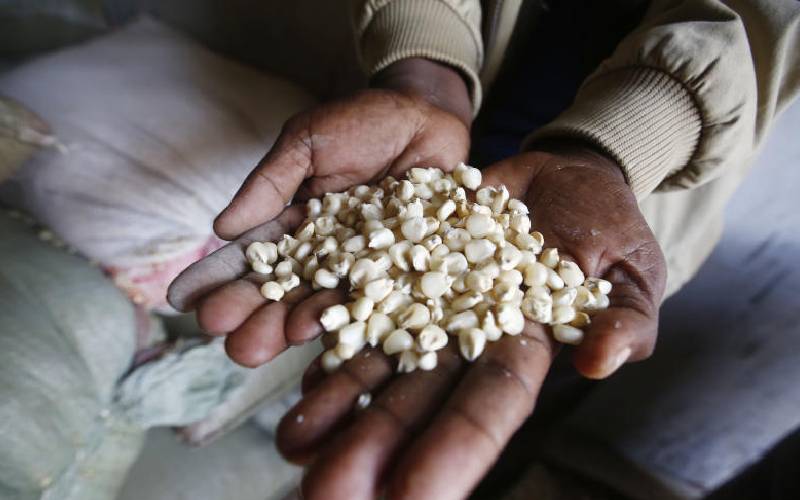Aflatoxin-contaminated animal feed explains presence of toxins in our plates

The lethality of the toxin called aflatoxin is in the fact that it targets the DNA of any organism that consumes it.
The DNA is the gene carrying molecule in the body that is responsible for the expression of all the traits in an individual. This means that all the proteins that are manufactured in the body find their origin from the DNA of an individual.
The moment this important molecule called DNA is altered differently from the normal way it functions, it means that it will express itself (produce) the proteins according to the alteration.
Now, this is the aspect that aflatoxin capitalizes on and alters the way a person’s DNA should work and express its proteins.
In simple language, the aim of digestion is to break down complex molecules to simple molecules that can be readily taken up by the body and assimilated so that they should be used up again in the body for the build up of the body tissues.
On the same pedestal, when one consumes aflatoxin the DNA components in the aflatoxins are broken down to simple amino acids that would be assembled in the DNA of the one consuming it.
This means that the toxic nucleotides (gene components) of aflatoxin’s DNA will attach itself to the host DNA and forms adducts.
From this time on, it means that the host DNA will not produce (replicate) the normal protein but will produce the altered DNA with the aflatoxin adducts. This will continue for the many replications that will produce several such abnormal genes.
This is how cancerous cells are built up in the body. This is why aflatoxins are referred to as carcinogenic.
The reason for this brief preview of pathogenesis of aflatoxins is to underscore the importance of hygiene in handling food both for the animals kept for their products and for our consumption.
One of the traits of microbes Aspergilus flavus and Aspergilus parasiticus strains of fungi which are responsible for the release of a toxic biological metabolite called the aflatoxin is that they undergo fast cell division and thus really multiply in such a tremendous rapidity.
The ideal condition for this quick multiplication is moisture content in grains and other food materials.
Many animal feeds manufacturing companies use materials like maize cobs that are being crushed or ground and mixed with other nutrients to come up with a formula for animals.
To refrain from pointing accusing fingers to the animal feeds manufacturing companies, I would want to point out that most of the times, maize cobs are not kept in hygienic condition.
Because of their large moisture contents, they facilitate the breeding of lots of aflatoxins in them which find themselves in the animal feeds. When the animals feed on this, the DNA of aflatoxins form adducts with those of the animals.
This means that meat, milk, and eggs from such animals would have had some cancerous (deleterious) genes that would inflict cancer to any who feed on such. The overriding fact is that they should always be absolutely dry/ free from any moisture.
This now shows the importance of every person that is tasked with handling our grains; especially maize which is our staple food to cautiously embrace hygiene in every step of handling them.
Much as we applaud the Ministry of Agriculture for introduction of biological control products like aflasafe that would curb aflatoxin in the fields; the government should also invest on electric driers to ensure that any maize consignment brought to the NCPB is dried thoroughly before storage.
This will ensure that the issue of moisture does not facilitate the growth of the Aspergilus.
Most importantly is for the soil experts to find a way of detoxifying the Kenyan farms whose soil is reported to be contaminated with aflatoxins.
Bunning maize flour products after they have reached the shelves as recently witnessed is a knee-jerk reaction that cannot resolve anything but addressing the problem superfluously.
The five maize brands have since been given a clean bill of health as being free from the aflatoxins and are back in the shelves.
The recently formed team to probe the issues of contaminated maize has not pronounced itself on the same but the maize brands are already being consumed.
Recall the mercury contaminated sugar that found itself in the Kenyan market and you would agree with me that ours is a society consuming toxins at the behest of irresponsible “experts” tasked with protecting the citizenry from such.
Otherwise, hygiene is central in handling not only maize and other cereals that are consumable to man and susceptible to aflatoxins, but also animal feeds harbor aflatoxins.
Want to get latest farming tips and videos?
Join Us
Share this article on social
 The Standard Group Plc is a multi-media organization
with investments in media platforms spanning newspaper print operations,
television, radio broadcasting, digital and online services. The Standard Group
is recognized as a leading multi-media house in Kenya with a key influence in
matters of national and international interest.
The Standard Group Plc is a multi-media organization
with investments in media platforms spanning newspaper print operations,
television, radio broadcasting, digital and online services. The Standard Group
is recognized as a leading multi-media house in Kenya with a key influence in
matters of national and international interest.
 The Standard Group Plc is a multi-media organization
with investments in media platforms spanning newspaper print operations,
television, radio broadcasting, digital and online services. The Standard Group
is recognized as a leading multi-media house in Kenya with a key influence in
matters of national and international interest.
The Standard Group Plc is a multi-media organization
with investments in media platforms spanning newspaper print operations,
television, radio broadcasting, digital and online services. The Standard Group
is recognized as a leading multi-media house in Kenya with a key influence in
matters of national and international interest.







